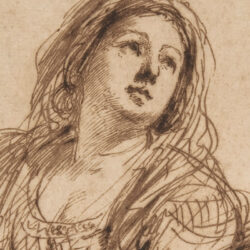Museum collections often require the attention of a conservator, whether this is to provide routine maintenance or prepare items for longterm display. The Paisley Museum and Art Gallery reached out to our team for assistance with their historic collection of Syrian glass.
 Above: Amy working on one of Paisley Museum’s glass vessels – image copyright of OneRen, the trading name of Renfrewshire Leisure Limited
Above: Amy working on one of Paisley Museum’s glass vessels – image copyright of OneRen, the trading name of Renfrewshire Leisure Limited
This historic collection had been kept in storage for decades, its value misunderstood by past curators. Today, the museum is working with the Syrian ESOL group to bring these important artefacts back to public view.
 Above: examples of Syrian glass including a head-shaped bottle (3rd century), amphoriskos (1st century), bottle (5th century), jug (4th-6th century) and grape-shaped bottle (3rd century)
Above: examples of Syrian glass including a head-shaped bottle (3rd century), amphoriskos (1st century), bottle (5th century), jug (4th-6th century) and grape-shaped bottle (3rd century)
Out of all materials, glass is the least amenable to repair. Due to its clear and refractive nature, damage cannot be effectively blended or disguised in the same way as an opaque material such as terracotta or porcelain. However, when glass is antique enough to have developed a patinated surface – such as a layer of iridescence, clouding, or weathering – preservation work can be more easily concealed, whilst preventing further deterioration and allowing the historic integrity of the appearance to remain intact.
 Above: an example of 2nd-3rd century Syrian glass covered in an iridescent layer caused by weathering and age
Above: an example of 2nd-3rd century Syrian glass covered in an iridescent layer caused by weathering and age
Our objects conservator Amy travelled to Paisley to prepare their Syrian glass collection for display. The historic objects had developed layers of iridescence, requiring precise treatments to stabilise the surface. The Paisley Museum glass collection dates back over 2000 years, making this a vital task for ongoing preservation.
 Above: four examples of Syrian glass from the Paisley collection, all showing different forms of decoration and weathering
Above: four examples of Syrian glass from the Paisley collection, all showing different forms of decoration and weathering
A short history of Syrian glass
Developed by Syrian craftsmen during the 1st century BC, glass blown vessels for luxury and everyday use were produced and exported throughout the Roman and early Byzantine Empires. Glassblowing became a flourishing industry in the areas Sidon, Tyre, Aleppo and Hama, as well as thriving in the countries’ capital, Damascus.
 Above: examples of Syrian glass including a goblet (2nd-3rd century), flask (3rd-4th century), Amphora (2nd century), bottle (3rd-4th century), and pitcher (2nd century)
Above: examples of Syrian glass including a goblet (2nd-3rd century), flask (3rd-4th century), Amphora (2nd century), bottle (3rd-4th century), and pitcher (2nd century)
Glass blown vessels had a variety of uses. They were commonly displayed as a domestic decoration, or could be used as a cosmetics container. Aryballos, for example, would be used as a container for scented oils. In Damascus, the craft was considered a profession of high status and was well paid for the artists and craftsmen who practised it.
 Above: two Syrian glass cosmetic kohl tubes and a bowl (all 4th-5th century)
Above: two Syrian glass cosmetic kohl tubes and a bowl (all 4th-5th century)
Glassblowing techniques have, overall, remained unchanged since their conception, and were originally passed down generation through generation. Pieces of glass are made to melt in a brick oven, before being twisted around a hollow metal rod. A craftsman would then blow into the rod, inflating the glass and moulding it into different shapes with metal tongs. Additions to the vessel, such as stems or handles, would then be attached through welding.
 Above: four examples of Syrian glass all dating to the 1st century
Above: four examples of Syrian glass all dating to the 1st century
The glass is then coloured with powdered dyes whilst it is still in a melted state, or painted on when the glass has cooled and hardened. Cultural symbols are often then painted or engraved into the hardened glass, with the Hamsa or “Hand of Fatima” used as a common icon found on Syrian glass. Damascene glass in particular is distinguished by green, blue and crimson coloured glass, often with hand painted, golden motifs.
Preserving the Paisley Museum’s glass collection
The Paisley Museum and Art Gallery have a Syrian glass collection that was entrusted to the museum in 1948 by Elizabeth Spires Paterson. She is believed to have collected these stunning glass artefacts from antiques dealers in Syria during the early 20th century. They remained in storage for 70 years, until a new curator realised their significance. The museum is currently undergoing a £42m redevelopment and the Syrian glass collection was selected for display.
 Above: Amy working on one of Paisley Museum’s glass vessels – image copyright of OneRen, the trading name of Renfrewshire Leisure Limited
Above: Amy working on one of Paisley Museum’s glass vessels – image copyright of OneRen, the trading name of Renfrewshire Leisure Limited
These beautiful glass vessels were all suffering from weathering with delicate surface flakes at risk of detachment and loss. This type of deterioration is typical of archaeological glass and occurs while the objects are buried. Alkali ions are leached from the glass by moisture in the surrounding soil, resulting in a fragile surface crust, and subsequent iridescent layers.
 Above: details from Amy’s treatment of a Syrian glass vessel
Above: details from Amy’s treatment of a Syrian glass vessel
In these cases, the layers of iridescence should not be removed, even though the original colour of the glass would be revealed. This is because the iridescence and other layers of deterioration are actually decaying glass, and therefore, part of the object itself.
 Above: an example of Syrian glass from the Paisley collection, the breakage and ancient patina were stabilised rather than being restored
Above: an example of Syrian glass from the Paisley collection, the breakage and ancient patina were stabilised rather than being restored
Deteriorated layers are very important elements of ancient glass objects because they retain the shape and texture of the original surface. This can provide information about how the vessels were produced, decorated, and used.
Our conservator Amy carefully applied very dilute conservation-grade adhesive beneath the flaking areas and held them in place with a bamboo toothpick while the adhesive cured.
 Above: Amy working on one of Paisley Museum’s glass vessels – image copyright of OneRen, the trading name of Renfrewshire Leisure Limited
Above: Amy working on one of Paisley Museum’s glass vessels – image copyright of OneRen, the trading name of Renfrewshire Leisure Limited
Through careful puzzling, she was even able to reattach some flakes that had detached in the past. This treatment consolidated and strengthened the fragile flakes and allowed the glass vessels to be safely handled and displayed, while also preserving significant information about their surfaces for the archaeological record.
It was a pleasure to assist the Paisley Museum team with their preparations and we are looking forward to visiting when the refurbished building opens. You can find out more about the transformation of the museum and gallery here.
How can we help?
If you have any questions about art restoration and conservation including glass restoration, please do not hesitate to get in touch. As part of our service we offer a nationwide collection and delivery service. E-mail us via [email protected] or call 0207 112 7576 for more information.

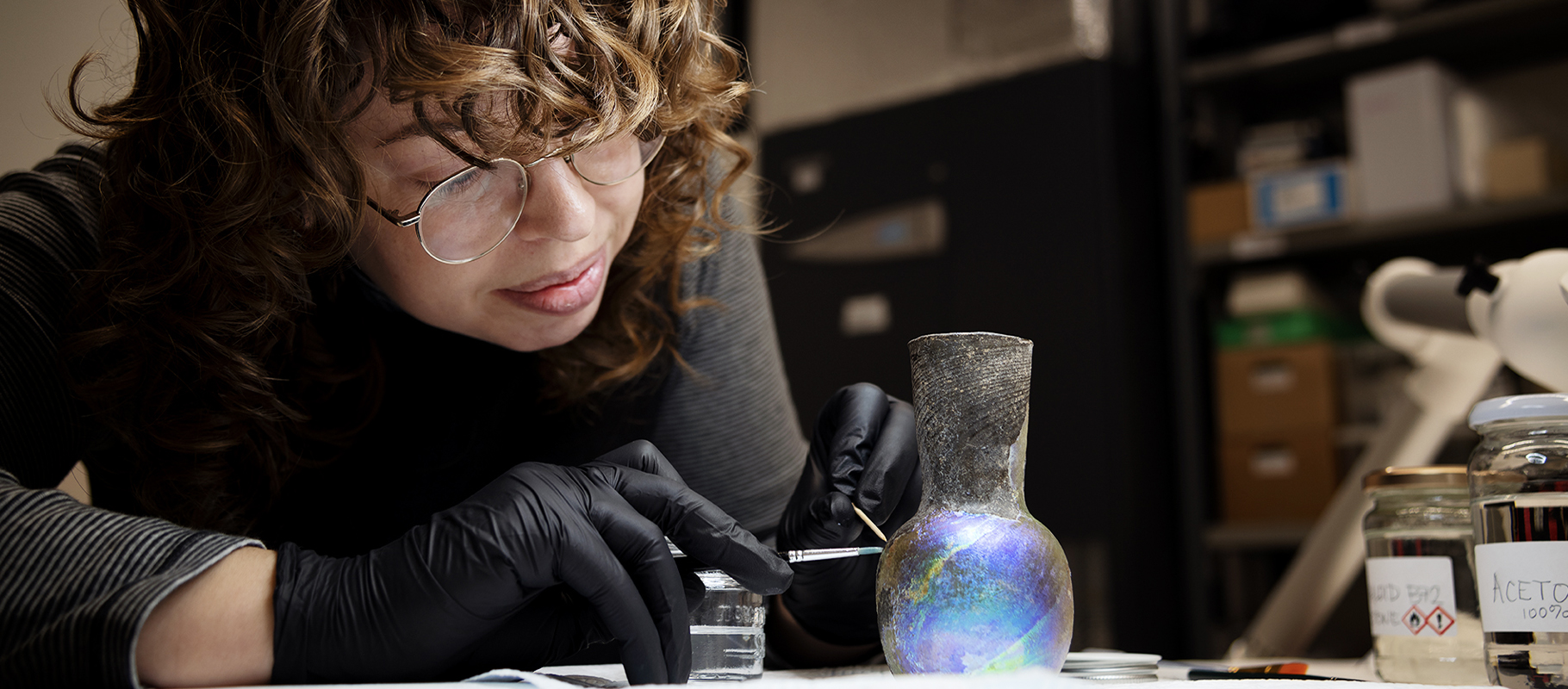 Above: Amy working on one of Paisley Museum’s glass vessels – image copyright of OneRen, the trading name of Renfrewshire Leisure Limited
Above: Amy working on one of Paisley Museum’s glass vessels – image copyright of OneRen, the trading name of Renfrewshire Leisure Limited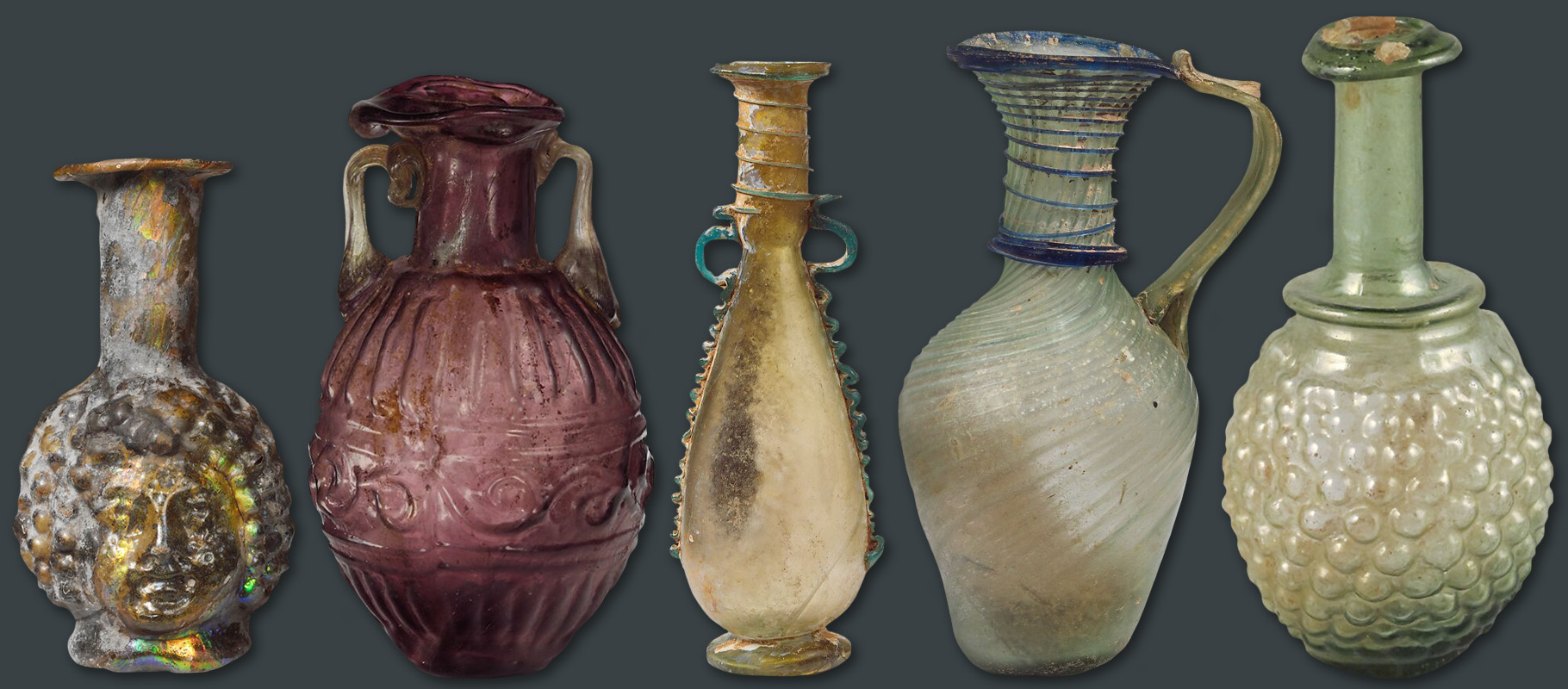 Above: examples of Syrian glass including a head-shaped bottle (3rd century), amphoriskos (1st century), bottle (5th century), jug (4th-6th century) and grape-shaped bottle (3rd century)
Above: examples of Syrian glass including a head-shaped bottle (3rd century), amphoriskos (1st century), bottle (5th century), jug (4th-6th century) and grape-shaped bottle (3rd century) Above: an example of 2nd-3rd century Syrian glass covered in an iridescent layer caused by weathering and age
Above: an example of 2nd-3rd century Syrian glass covered in an iridescent layer caused by weathering and age Above: four examples of Syrian glass from the Paisley collection, all showing different forms of decoration and weathering
Above: four examples of Syrian glass from the Paisley collection, all showing different forms of decoration and weathering  Above: examples of Syrian glass including a goblet (2nd-3rd century), flask (3rd-4th century), Amphora (2nd century), bottle (3rd-4th century), and pitcher (2nd century)
Above: examples of Syrian glass including a goblet (2nd-3rd century), flask (3rd-4th century), Amphora (2nd century), bottle (3rd-4th century), and pitcher (2nd century)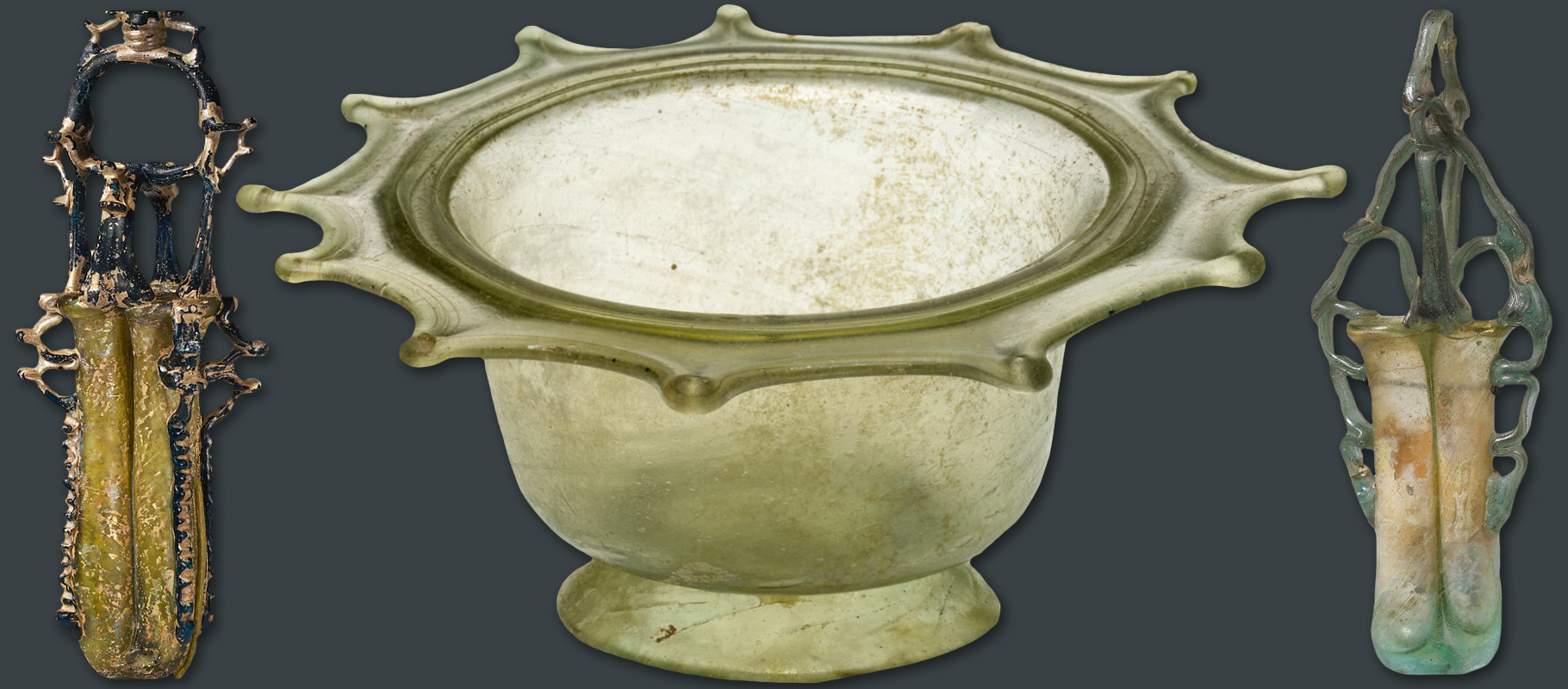 Above: two Syrian glass cosmetic kohl tubes and a bowl (all 4th-5th century)
Above: two Syrian glass cosmetic kohl tubes and a bowl (all 4th-5th century)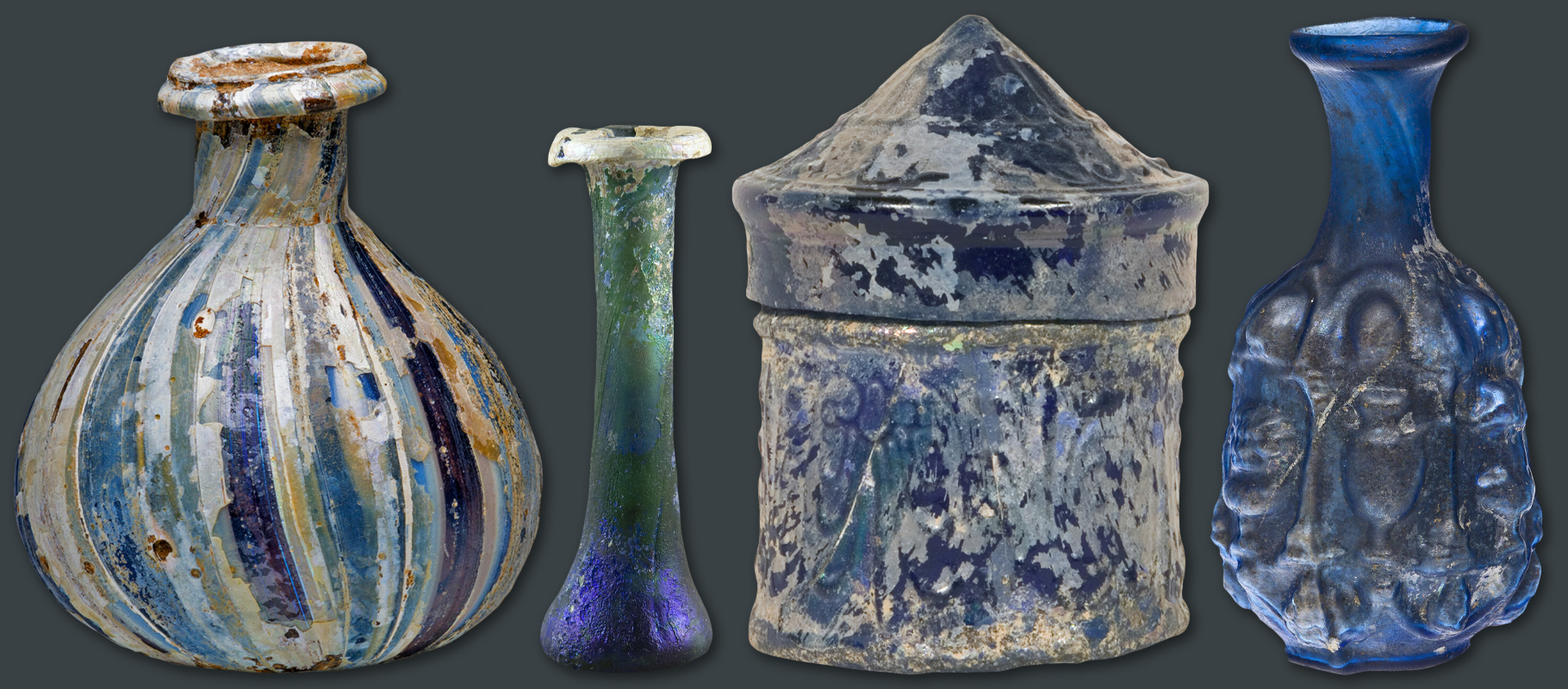 Above: four examples of Syrian glass all dating to the 1st century
Above: four examples of Syrian glass all dating to the 1st century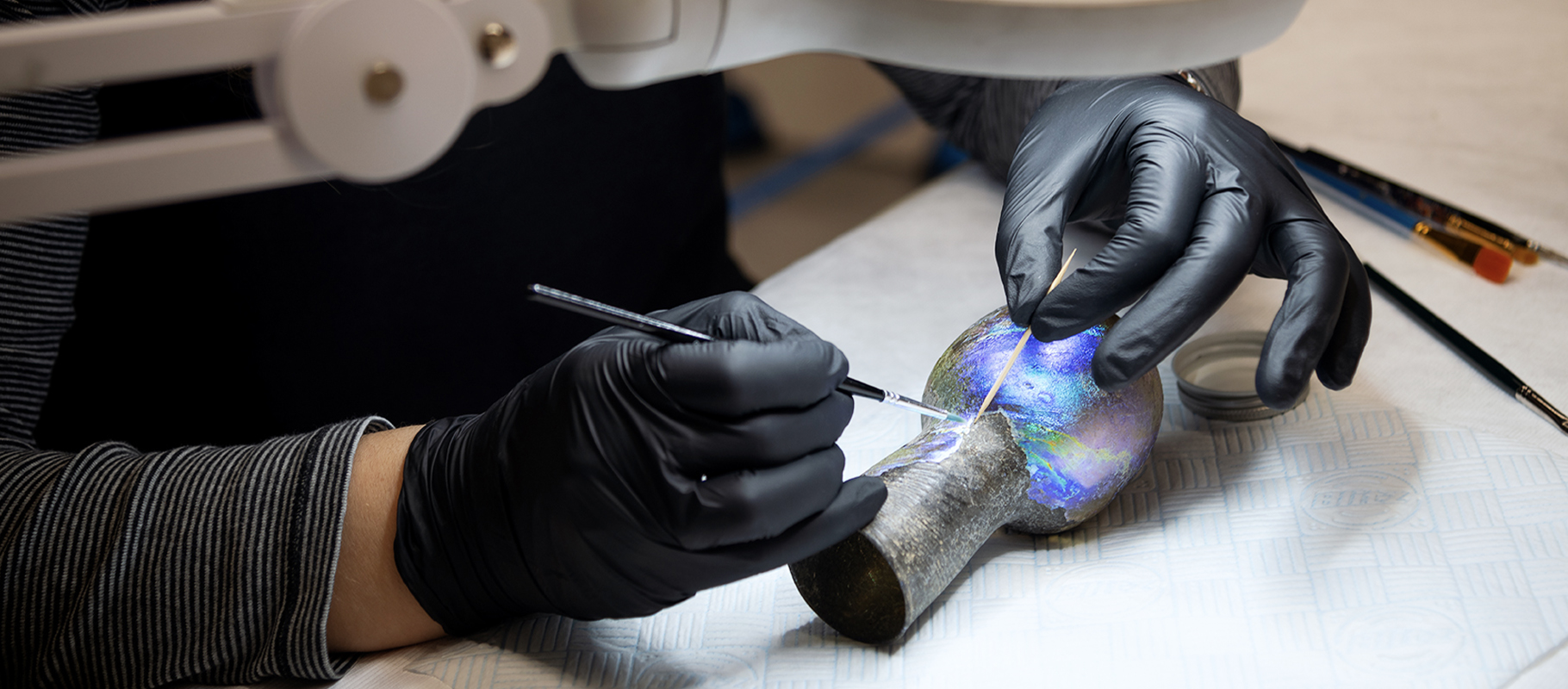 Above: Amy working on one of Paisley Museum’s glass vessels – image copyright of OneRen, the trading name of Renfrewshire Leisure Limited
Above: Amy working on one of Paisley Museum’s glass vessels – image copyright of OneRen, the trading name of Renfrewshire Leisure Limited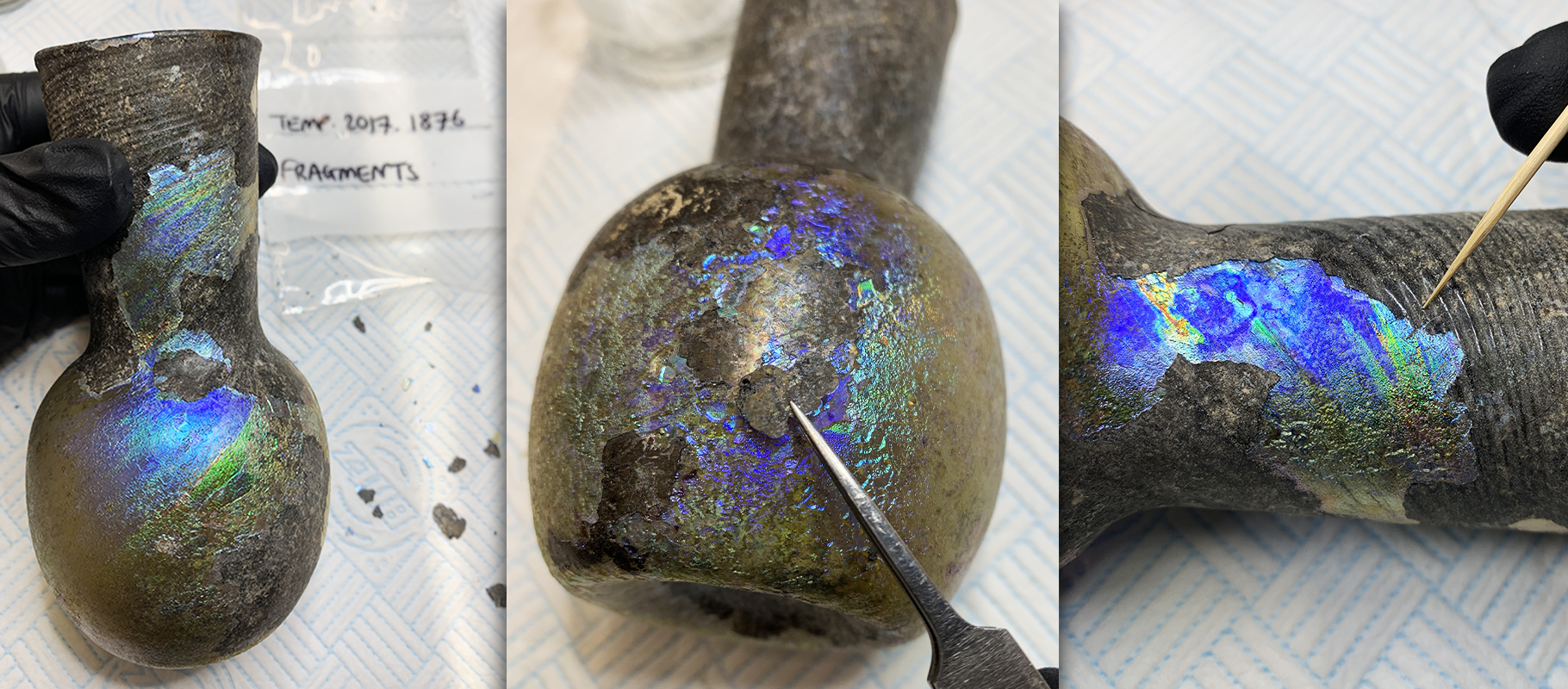 Above: details from Amy’s treatment of a Syrian glass vessel
Above: details from Amy’s treatment of a Syrian glass vessel Above: an example of Syrian glass from the Paisley collection, the breakage and ancient patina were stabilised rather than being restored
Above: an example of Syrian glass from the Paisley collection, the breakage and ancient patina were stabilised rather than being restored 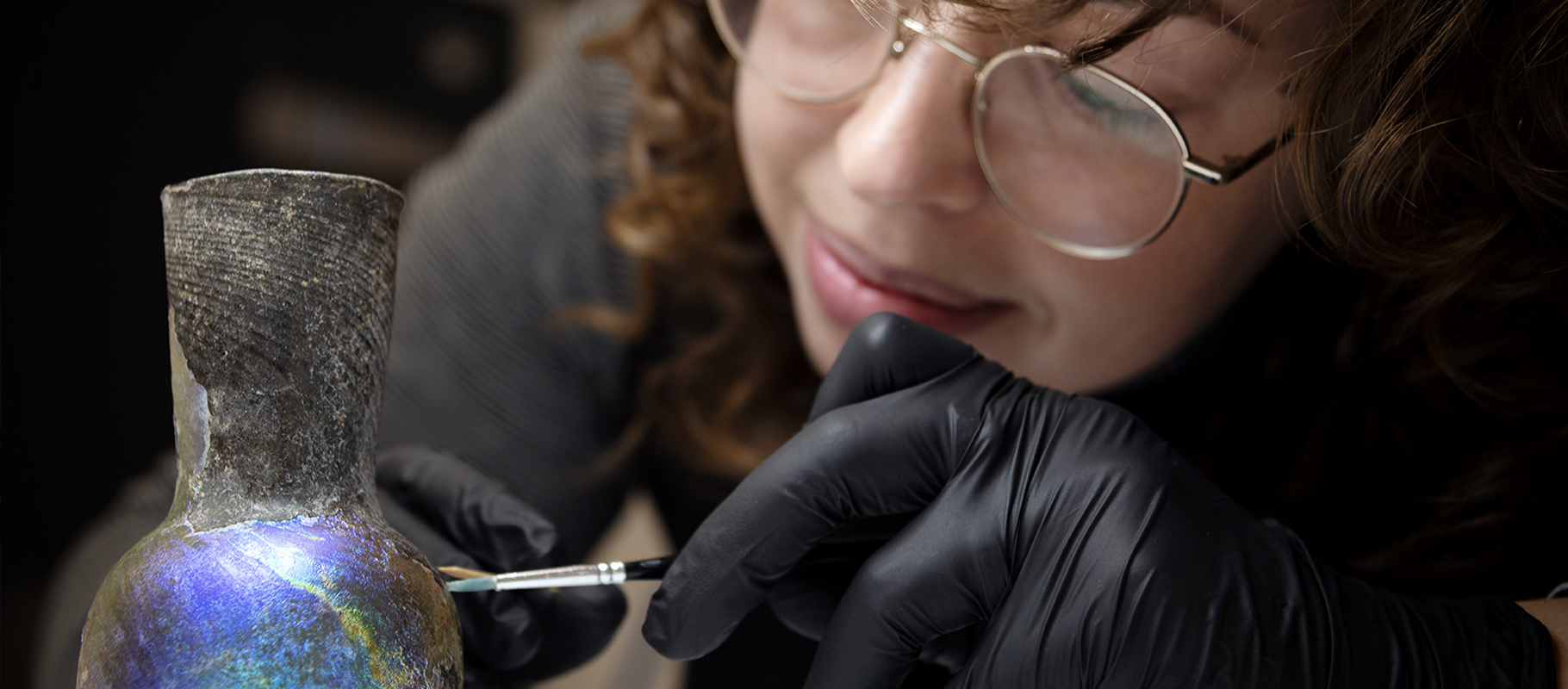 Above: Amy working on one of Paisley Museum’s glass vessels – image copyright of OneRen, the trading name of Renfrewshire Leisure Limited
Above: Amy working on one of Paisley Museum’s glass vessels – image copyright of OneRen, the trading name of Renfrewshire Leisure Limited




